Unitarianism is a nontrinitarian Christian theological movement that believes that the God in Christianity is one singular person. Most other branches of Christianity define God as one being in three persons: the Father, Son, and Holy Spirit. Unitarian Christians believe that Jesus was inspired by God in his moral teachings and that he is a savior, but he is not God incarnate.

Joseph Priestley was an English chemist, natural philosopher, separatist theologian, grammarian, multi-subject educator, and liberal political theorist who published over 150 works.
The General Assembly of Unitarian and Free Christian Churches is the umbrella organisation for Unitarian, Free Christians, and other liberal religious congregations in the United Kingdom and Ireland. It was formed in 1928, with denominational roots going back to the Great Ejection of 1662. Its headquarters is Essex Hall in central London, on the site of the first avowedly Unitarian chapel in England, set up in 1774.
The Polish Brethren were members of the Minor Reformed Church of Poland, a Nontrinitarian Protestant church that existed in Poland from 1565 to 1658. By those on the outside, they were called "Arians" or "Socinians", but themselves preferred simply to be called "Brethren" or "Christians," and, after their expulsion from Poland, "Unitarians".

The Priestley Riots took place from 14 July to 17 July 1791 in Birmingham, England; the rioters' main targets were religious dissenters, most notably the politically and theologically controversial Joseph Priestley. Both local and national issues stirred the passions of the rioters, from disagreements over public library book purchases, to controversies over Dissenters' attempts to gain full civil rights and their support of the French Revolution.

Bournbrook is an industrial and residential district in southwest Birmingham, England, in both the Selly Oak Council Ward and the Parliamentary District of Selly Oak. Prior to what is commonly termed the Greater Birmingham Act, which came into effect on 9 November 1911, the Bourn Brook watercourse was the North Eastern boundary of Worcestershire, and the area was locally governed by the King’s Norton and Northfield Urban District Council.

Robert Robinson was an English Dissenter, influential Baptist and scholar who made a lifelong study of the antiquity and history of Christian Baptism. He was also author of the hymns "Come Thou Fount of Every Blessing" and "Mighty God, while angels bless Thee", the former of which he wrote at age 22 after converting to Methodism. The latter was later set to music by Dr John Randall, Music Professor at Cambridge University.
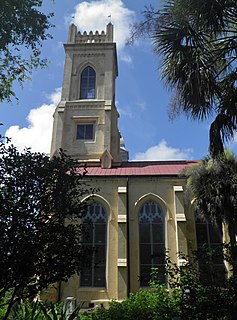
The Unitarian Church in Charleston, home to a Unitarian Universalist congregation, is an historic church located at 4 Archdale Street in Charleston, South Carolina. It is the oldest Unitarian church in the South and the second oldest church building on the peninsula of Charleston.

St. Stephen's Church is a historic church in the North End of Boston, Massachusetts. It was built in 1802-04 as the New North Church or New North Meeting House, and was designed by the noted architect Charles Bulfinch. It is the only one of the five churches Bulfinch designed in Boston to remain extant. The church replaced one which had been built on the site in 1714 and enlarged in 1730. The Congregationalist church became Unitarian in 1813, and the church was sold to the Roman Catholic Diocese in 1862, and renamed St. Stephen's. It was restored and renovated in 1964-65 by Chester F. Wright, and was added to the National Register of Historic Places in 1975.
The Roman Catholic parish of St Anne, Nuneaton in Warwickshire, England serves the western side of Nuneaton and outlying villages towards Coleshill. The parish is part of the Roman Catholic Archdiocese of Birmingham and a part of the Rugby Deanery. The current Parish Priest is Fr. George.
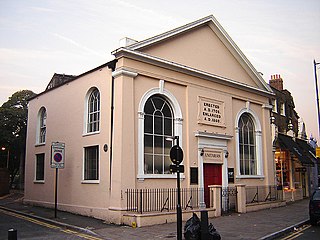
Newington Green Unitarian Church (NGUC) in north London is one of England's oldest Unitarian churches. It has had strong ties to political radicalism for over 300 years, and is London's oldest Nonconformist place of worship still in use. It was founded in 1708 by English Dissenters, a community of which had been gathering around Newington Green for at least half a century before that date. The church belongs to the umbrella organisation known as the General Assembly of Unitarian and Free Christian Churches, and has had an upturn in its fortunes since the turn of the millennium.
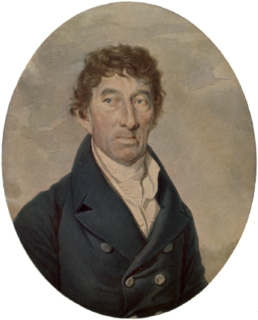
William Russell was a practical Christian, a Birmingham merchant, a practising Unitarian, and a close friend and sponsor of Joseph Priestley. He promoted and defended Rational Christianity, and helped lead the agitation for the repeal of penal laws against Dissenters, canvassing support for a political union of the nation's Dissenters.
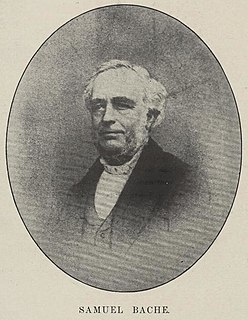
Samuel Bache was an English Unitarian minister.
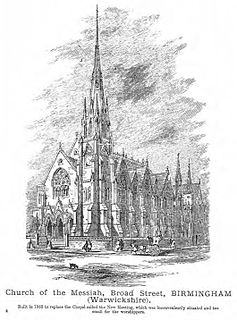
The Church of the Messiah, Birmingham was a Unitarian church on Church Street. The congregation continues, having moved to purpose-built premises at Five Ways in 1973. The impressive Victorian building was demolished in 1978.

St Francis of Assisi Church is a Roman Catholic Parish church in Birmingham. While the church is located between the Lozells and Hockley parts of the city, the parish covers most of Handsworth. It was founded in 1840, originally as a chapel in the nearby listed building, St. Mary's Convent designed by Augustus Pugin.

St Catherine of Siena Church is a parish of the Roman Catholic Church situated on Bristol Street in Birmingham, in the Archdiocese of Birmingham. Founded in 1874, its parish church was demolished and replaced in 1964. It was run by the Missionary Society of St. Columban from 2005 to 2013.

St Mary's Convent is a house for the community of the local Sisters of Mercy in Birmingham. Although it is situated between the Lozells and Hockley parts of the city, the community also serves the parish in Handsworth. It was founded in 1840 and was designed by Augustus Pugin. On 25 April 1952 it was designated as a Grade II* listed building by English Heritage.

St Anne's Church is a Roman Catholic Parish church on Alcester Street in Digbeth, part of the city centre of Birmingham. It was founded by Saint John Henry Newman in 1849. It was moved to a new building in 1884 designed by London architects Albert Vicars and John O'Neill, who also designed St Hugh's Church in Lincoln, and helped design St Peter's Cathedral in Belfast.

Our Lady of Mount Carmel and St Patrick Church or St Patrick's Church is a Roman Catholic Parish church in Oldham, Greater Manchester, England. It was founded in 1858 and was built in 1870. It is situated on the corner of John Street and Union Street West, north of Oldham Sixth Form College in the centre of the town. It is a Gothic Revival church and is a Grade II listed building.
John Edwards (1768–1808) was an English nonconformist minister and political radical. He is best known as the successor of Joseph Priestley at the New Meeting House, Birmingham.


















